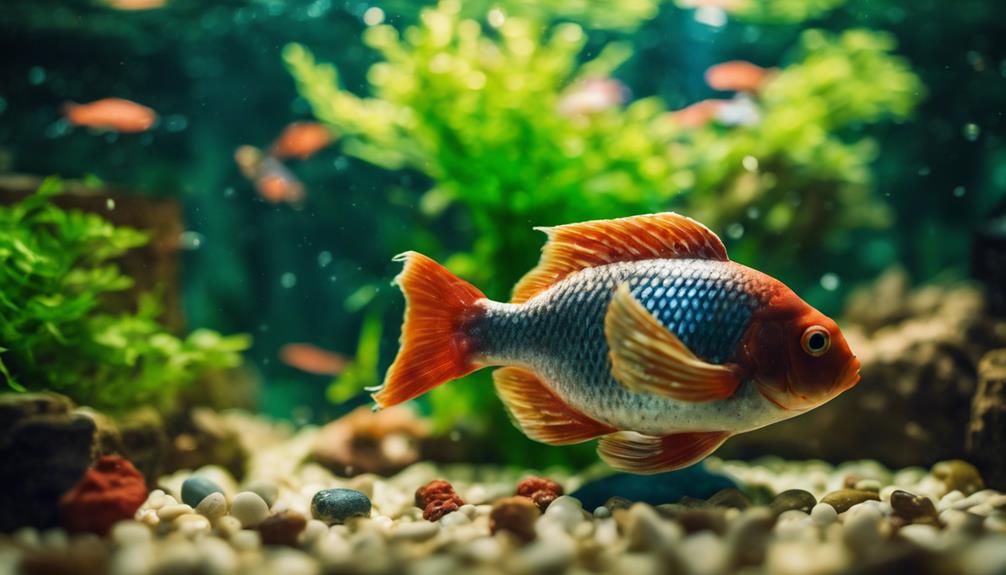By replicating their natural environment and minimizing stress, you can substantially boost your fish's immune system and prevent diseases. Provide hiding places, visual barriers, and a varied high-quality diet to reduce stress and aggression. Monitor fish behavior, observing changes in appetite, lethargy, or erratic swimming patterns to detect potential health issues early. Quarantine new fish, feed a nutritious diet, and maintain good water quality through regular partial water changes. Keep an eye on water parameters, and use supplements and medication only as needed. By following these natural methods, you'll be well on your way to creating a thriving aquatic community, and there's even more to explore to confirm your fish stay happy and healthy.
Table of Contents
Key Takeaways
- Replicating natural environments and providing hiding places reduces stress, boosting immune systems and preventing disease in fish.
- A varied diet of live, frozen, and homemade foods provides essential nutrients and beneficial bacteria, supporting overall fish health.
- Regular partial water changes (20-30% weekly) remove toxins, replenish minerals, and maintain stable water parameters, preventing stress and disease.
- Monitoring fish behavior and physical appearance helps detect early signs of disease or stress, allowing for prompt action and treatment.
- Quarantining new fish for 2-4 weeks prevents disease transmission, reduces stress, and ensures healthy integration into the main aquarium.
Reduce Stress With Proper Habitat
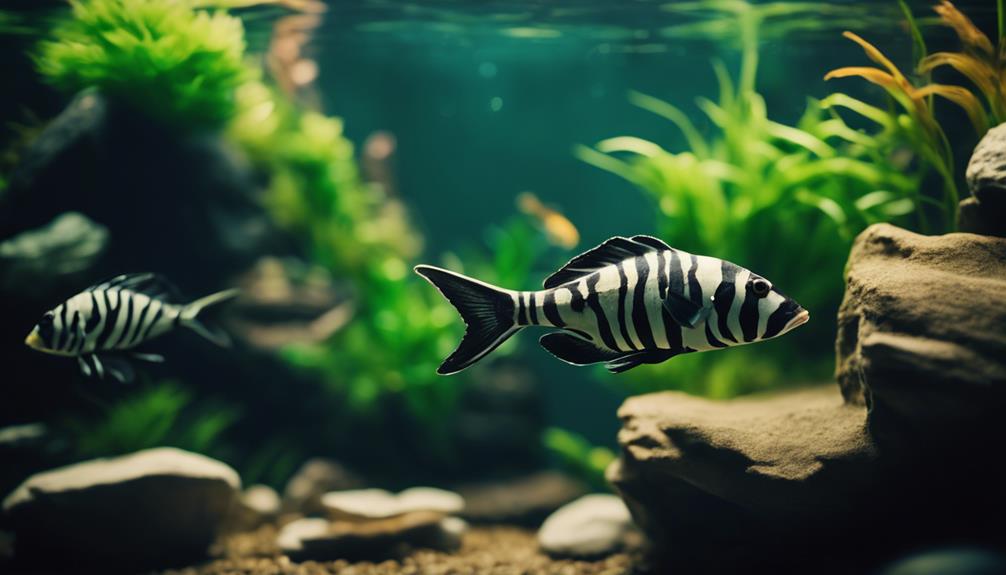
By replicating their natural environment as closely as possible, you can profoundly reduce stress in your fish, which is essential since inadequate habitat is a common culprit behind weakened immune systems and increased disease susceptibility.
Aquarium fish thrive in environments that mimic their natural habitats, where they can feel secure and relaxed.
To create this haven, provide adequate hiding places and visual barriers, such as plants, rocks, or driftwood, which give your fish a sense of security and territory. This, in turn, helps reduce stress and aggression among your aquatic friends.
A well-maintained aquarium with regular partial water changes, filter maintenance, and a varied high-quality diet also contribute to a stress-free environment.
By minimizing stress, you're helping your fish develop a strong immune system, making them more resilient to disease.
Recognize Disease Symptoms Early
As you endeavor to keep your aquatic friends thriving, it's vital to recognize disease symptoms early on.
You'll want to keep a close eye on your fish's behavior, observing any changes that could indicate illness.
Monitor Fish Behavior
You can identify potential health issues in your fish by observing their behavior and recognizing subtle changes in their normal activities, such as feeding, swimming, or social interactions.
By monitoring their fish behavior, you can detect early signs of disease or stress, which is vital for maintaining healthy fish. A healthy fish will typically swim actively, feed zealously, and interact with its tankmates.
Look for changes in appetite, lethargy, or erratic swimming patterns, as these can indicate underlying health issues.
Additionally, observe your fish's physical appearance, such as changes in color, fins, or scales.
Monitor their respiration rate, as rapid gilling can be a sign of stress or disease.
By regularly observing your fish's behavior, you can quickly identify any deviations from their normal behavior, allowing you to take prompt action to address any potential health issues.
This proactive approach will help you maintain a healthy aquatic environment and guarantee the well-being of your fish.
Observe Feeding Time
During feeding time, pay attention to your fish's appetite and feeding behavior, as changes in these areas can be early indicators of disease or stress.
If your fish is eating less or showing no interest in their fish meal, it may be a sign of underlying health issues. Observe how your fish eat during feeding time – do they rush to the surface, or do they hesitate? Healthy fish typically have a strong appetite and will enthusiastically devour their food.
If you notice your fish is eating slowly or avoiding certain foods, it could indicate digestive problems or parasites.
Take note of any changes in feeding behavior, such as fish eating at the surface instead of mid-water or bottom-dwellers.
This can indicate respiratory issues or water quality problems. Also, monitor how long it takes for your fish to finish their meal. If they're taking longer than usual, it may be a sign of lethargy or decreased metabolism.
Look for Physical Signs
Regularly inspect your fish for physical signs of disease or distress, such as labored breathing, erratic swimming, or visible wounds, as early recognition of these symptoms can substantially improve treatment outcomes.
By monitoring your fish's behavior and appearance, you can catch potential issues before they become severe. Look for subtle changes, like a decrease in appetite or lethargy, which can indicate a compromised fish immune system.
Be aware of common fish diseases like Lateral Line Erosion, a bacterial infection that causes lesions along the lateral line. Observe your fish's body for signs of infection, such as redness, swelling, or ulcers.
Also, check for physical injuries or parasites that can cause stress and weaken your fish's immune system. By recognizing these physical signs early, you can take prompt action to address the issue, preventing more serious health problems from developing.
Quarantine New Fish to Prevent Disease
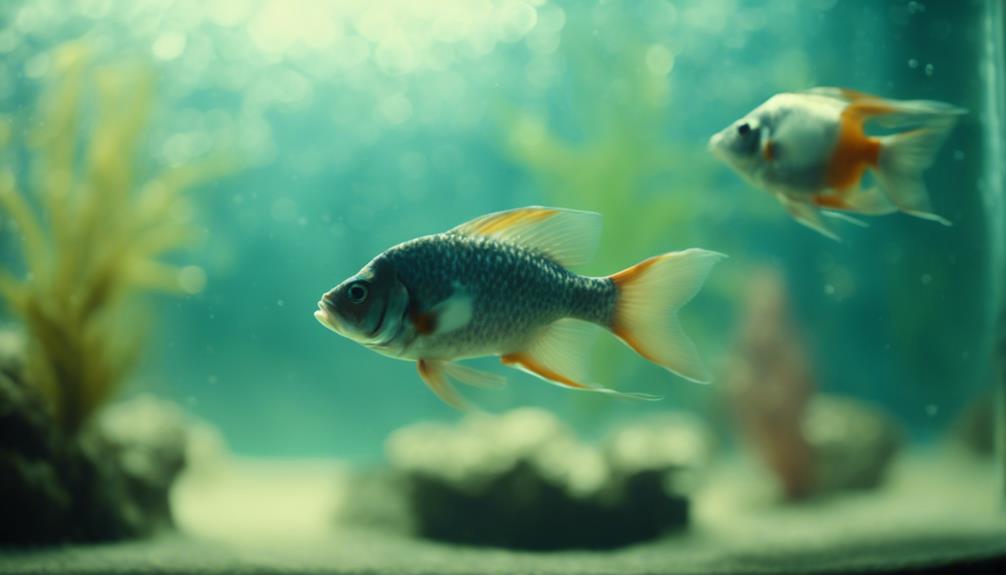
By setting up a separate quarantine tank for at least 2-4 weeks, you're fundamentally creating a safeguard against the introduction of diseases and parasites into your main aquarium. This vital step helps guarantee excellent water quality and allows beneficial bacteria to establish themselves in the quarantine tank.
Prevents disease transmission: Quarantining new fish prevents the spread of diseases and parasites to your existing fish population.
Reduces stress: Quarantining new fish reduces stress, which can weaken their immune system and make them more susceptible to disease.
Allows for observation and treatment: Quarantining new fish allows you to observe and treat any diseases or parasites before they can spread to other fish in the main aquarium.
Guarantees healthy integration: Quarantining new fish guarantees that they're healthy and disease-free before introducing them to your main aquarium, promoting a harmonious and thriving community.
Feed a Varied and Nutritious Diet
You can substantially boost your fish's immune system and overall health by feeding a varied diet that incorporates live, frozen, and homemade foods.
By doing so, you'll provide a broad spectrum of nutrients and beneficial bacteria, which are essential for maintaining a healthy gut.
Live foods like California blackworms and brine shrimp can be easily cultured at home, offering a convenient and nutritious option.
Frozen foods like Hikari and PE Mysis flake are also a great choice, providing a convenient and healthy alternative.
While pellets and flakes can be used as a supplement, they shouldn't be the primary source of nutrition, as they lack live bacteria.
Consider preparing homemade fish food recipes tailored to your fish's specific needs.
Ingredients like mackerel, spirulina, and reef roids can provide a cost-effective and healthy alternative to commercial foods.
Rotating foods and feeding a variety of options can prevent boredom and maintain a healthy appetite in fish.
By feeding a varied diet, you'll guarantee your fish receive all the necessary nutrients to thrive in their Freshwater Aquarium, surrounded by live plants and supported by Vitamin supplements.
With high-quality fish foods, you'll create a balanced and nutritious environment that promotes peak health and well-being.
Maintain Good Water Quality Naturally

As you work to maintain good water quality naturally, you'll want to focus on three key areas: regular water changes, monitoring water parameters, and balancing aquarium chemistry.
By prioritizing these factors, you'll be able to create a healthy environment that supports your fish's overall well-being.
Regular Water Changes
Twenty to thirty percent of your aquarium's water should be replaced weekly to prevent the accumulation of toxins, excess nutrients, and waste products that can stress fish and weaken their immune systems.
Regular water changes are essential to maintain good water quality, which is vital for your fish's health. By doing so, you'll create a stable and healthy environment that supports the natural immune function of your fish.
Removes toxins and waste: Prevents the buildup of harmful substances that can stress fish and weaken their immune systems.
Replenishes essential minerals: Guarantees your fish receive the nutrients they need to thrive.
Prevents algae blooms: Reduces the risk of water quality issues and diseases.
Maintains stable water parameters: Keeps your aquarium water quality high, which is essential for your fish's overall well-being.
Monitor Water Parameters
Regular water changes are just the first step in maintaining good water quality, and monitoring water parameters is equally important to guarantee your fish thrive in a healthy environment. You need to keep a close eye on several key parameters to safeguard your fish stay healthy.
| Parameter | Ideal Range |
|---|---|
| pH level | 6.5-8.5 |
| Ammonia and nitrite | 0 ppm |
| Nitrate levels | <20 ppm |
Monitoring these parameters will help you identify any issues before they become severe. For example, even small amounts of ammonia and nitrite can be toxic to your fish, so regular tests are essential. Maintaining a stable pH level is also imperative, as sudden changes can cause stress and illness in your fish. Regular water changes can help buffer against pH fluctuations. Additionally, keeping nitrate levels below 20 ppm will prevent algae growth and oxygen depletion, which can also cause stress and illness in your fish. By monitoring these parameters, you'll be able to make adjustments to create a healthy environment for your fish to thrive.
Balance Aquarium Chemistry
You can achieve a delicate balance in aquarium chemistry by implementing a few simple yet effective strategies that work in harmony to maintain good water quality naturally.
By doing so, you'll create a thriving environment for your fish to flourish.
To get started, follow these essential tips:
Perform regular water changes: Replace 10-15% of your aquarium water weekly to remove waste products and excess nutrients that can harm your fish.
Use a high-quality water conditioner: This will remove chlorine and chloramines from tap water, making it safe for your fish to thrive.
Monitor and maintain a stable pH level: Verify your pH level falls between 6.5-8.5, depending on your fish species, to prevent stress and disease.
Keep an eye on ammonia levels: Regularly test for ammonia to confirm your biological filter is functioning properly to break down waste.
Monitor and Control Water Parameters
As you plunge into the world of aquarium-keeping, maintaining a precise grasp on water parameters becomes imperative, as even slight fluctuations can have devastating effects on your fish's well-being.
Regularly testing water parameters such as ammonia, nitrite, and nitrate levels helps maintain a healthy environment for your fish and prevents disease.
You'll want to keep a close eye on these levels, as even small changes can be pernicious to your fish's health.
Monitoring water temperature, pH, and hardness is also pivotal, as sudden changes can stress your fish and make them more susceptible to disease.
Identifying any fluctuations early on is paramount to take corrective action.
By doing so, you can guarantee your fish thrive in a stable and healthy environment.
Remember, maintaining prime water quality is key to keeping your fish happy and healthy.
Provide Regular Partial Water Changes
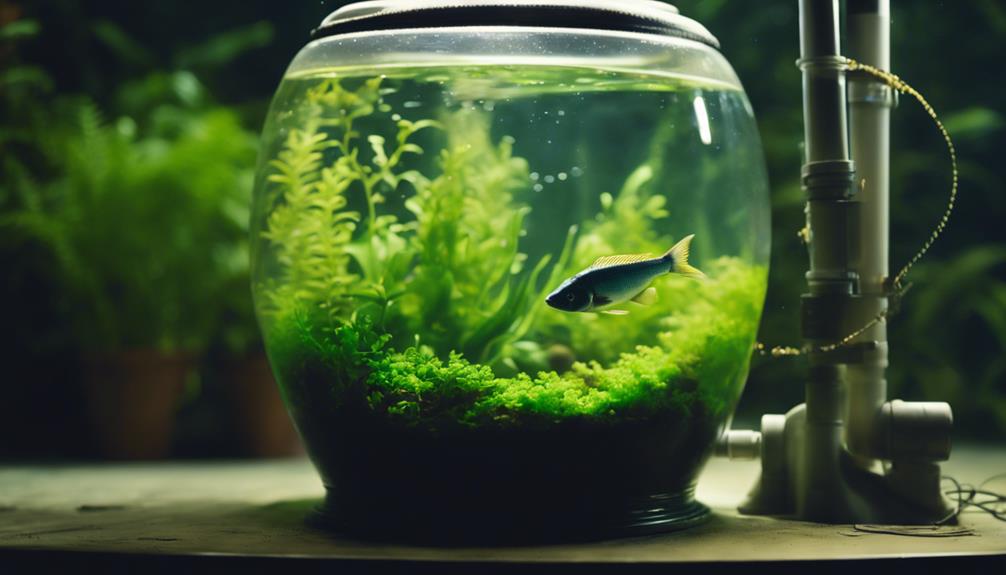
When you provide regular partial water changes, you're taking a vital step in maintaining superior water quality and reducing stress factors that can negatively impact your fish's health.
By doing so, you'll create a healthy environment that allows your fish to thrive, and you'll be able to identify any potential issues before they become major problems.
Regular water changes will help you stay on top of water quality maintenance, ensuring your fish receive the best possible care.
Water Quality Maintenance
Maintaining superior water quality is essential for fish health, and regular partial water changes are a pivotal component of this process.
You'll want to perform these changes weekly or bi-weekly, depending on your aquarium's bioload and water parameters.
Remove up to 25% of aquarium water and replace it with fresh, dechlorinated water that's the same temperature as your aquarium water.
Vacuum the gravel to remove waste and debris that can contribute to poor water quality and stress your fish.
Use a reliable water conditioner that removes chlorine, chloramines, and heavy metals, and detoxifies ammonia and nitrite.
Monitor water parameters as regular water changes help prevent the buildup of toxic compounds and maintain a stable environment for your fish.
Reduce Stress Factors
By incorporating regular partial water changes into your aquarium maintenance routine, you're not only maintaining superior water quality but also actively reducing stress factors that can weaken your fish's immune systems.
Regular water changes of 20-30% every week can help remove built-up toxins and waste products that can cause chronic stress in your fish.
This, in turn, helps to maintain prime water quality by replenishing essential minerals and nutrients that are depleted over time.
Inadequate water changes can lead to a buildup of nitrite, ammonia, and nitrate, making your fish more susceptible to disease.
By performing regular water changes, you're not only reducing stress factors but also minimizing the risk of waterborne diseases and parasites.
By making water changes a priority, you're creating a more stable and healthy environment for your fish to thrive in.
Use Medication Only as Needed
In the quest for ideal fish health, you'll find that a proactive approach to water quality and nutrition enables you to reserve medication as a last resort, rather than relying on it as a crutch. By taking care of the basics, you'll reduce the need for medication and create a thriving environment for your fish.
Maintain excellent water quality through regular partial water changes, filter maintenance, and using a high-quality water conditioner to remove chlorine and chloramines.
Use a quarantine aquarium to hold new fish before adding them to the main display aquarium, ensuring they're healthy and won't infect other fish.
Feed a high-quality diet that includes whole ingredients like salmon, krill, and shrimp, which can enhance fish health and reduce the need for medication.
Treat new fish preventatively to prevent the spread of disease and reduce the need for future medication.
Add Supplements for Extra Nutrition
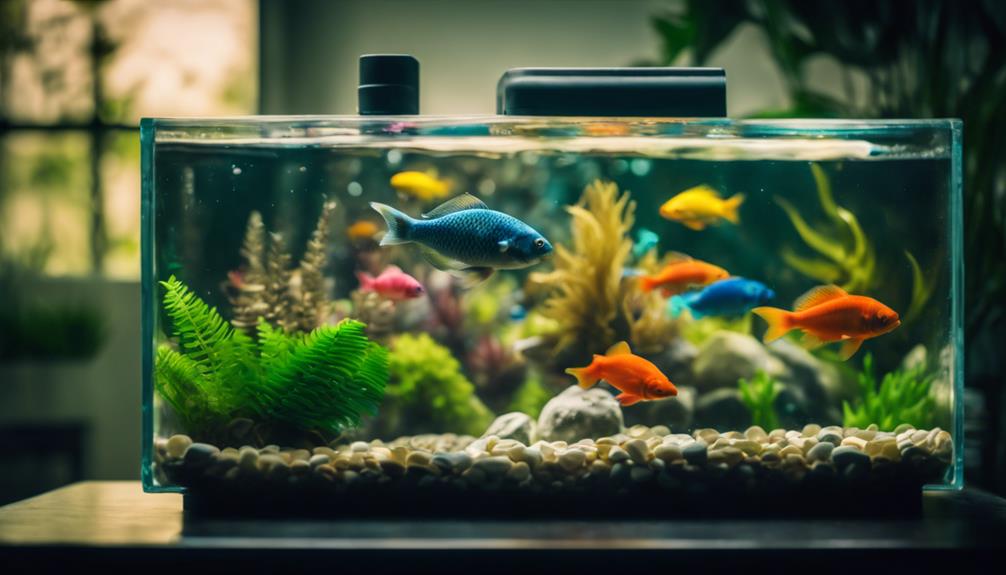
Adding targeted supplements to your fish's diet can substantially enhance their overall health, vigor, and coloration, while also supporting their immune system and reducing the need for medication.
You can consider adding Vitamin supplements like Vita-Chem to provide extra nutrition and enhance immune function. Beta glucan supplements can also be used to help sick or injured fish restore their natural immune response.
For a healthy coat, Omega-3 fatty acid supplements can be added to fish food to reduce inflammation and promote a shiny appearance. Fat supplements like Zoecon and Selcon can provide essential fatty acids that support healthy skin, scales, and fins, but be sure to feed them sparingly to avoid fatty liver disease.
Garlic supplements like Garlic Guard can be used to pre-soak fish foods, providing antimicrobial and antiparasitic properties that help prevent infections and promote digestive health.
Observe Fish Behavior for Health Clues
You can gain valuable insights into your fish's health by observing their behavior, as subtle changes can indicate underlying issues that may not be immediately apparent from physical examinations alone. By paying attention to your fish's behavior, you can help the fish by identifying potential problems early on and taking corrective action.
Appetite: If your fish cant or won't eat, it may be a sign of stress, disease, or poor water quality.
Swimming patterns: Changes in swimming patterns, such as rapid breathing, lethargy, or erratic movement, can indicate respiratory issues or other health problems.
Social interactions: Fish that normally school together may become aggressive or withdrawn if they're feeling unwell or stressed.
Resting behavior: Fish that spend more time resting or hiding than usual may be experiencing stress or fatigue.
Frequently Asked Questions
How to Boost Fish Immune System?
You can boost your fish's immune system by providing a healthy environment with natural defenses, using immune boosters like probiotics, and maintaining clean water with water purifiers, all of which work together to support their natural defenses.
How Can I Keep My Fish Healthy?
You're on the verge of disaster if you don't prioritize your fish's well-being! Guarantee their survival by maintaining superior water quality, performing regular tank maintenance, incorporating aquatic plants, and cleaning your filter frequently.
What Is the Healthiest Food for Fish?
You're wondering what the healthiest food for your finned friends is? Opt for high-quality fish pellets as a staple, and supplement with nutrient-rich Live brine, Frozen foods, and Spirulina flakes for a balanced and varied diet.
How to Help Sick Fish?
When your fish is ailing, think of it as a sailor lost at sea – you must chart a course for recovery. You'll need to anchor fish antibiotics, navigate regular water changes, quarantine the affected, and swab the tank clean to steer them back to health.
Conclusion
By following these 10 natural ways to boost fish health, you'll be well on your way to creating a thriving aquatic environment.
Did you know that a staggering 90% of fish die within the first year of captivity due to preventable diseases and stress?
By taking proactive measures, you can substantially increase your fish's lifespan and enjoy a vibrant, healthy aquarium for years to come.

